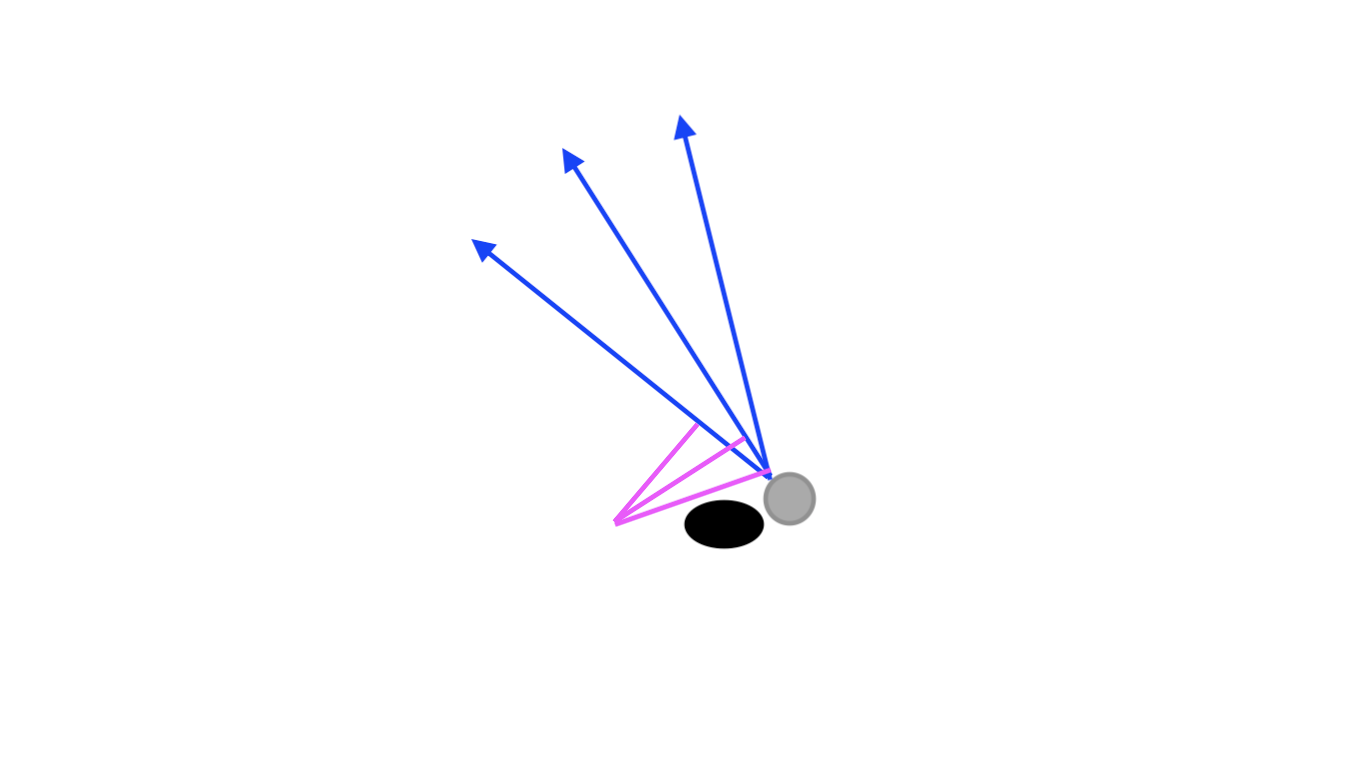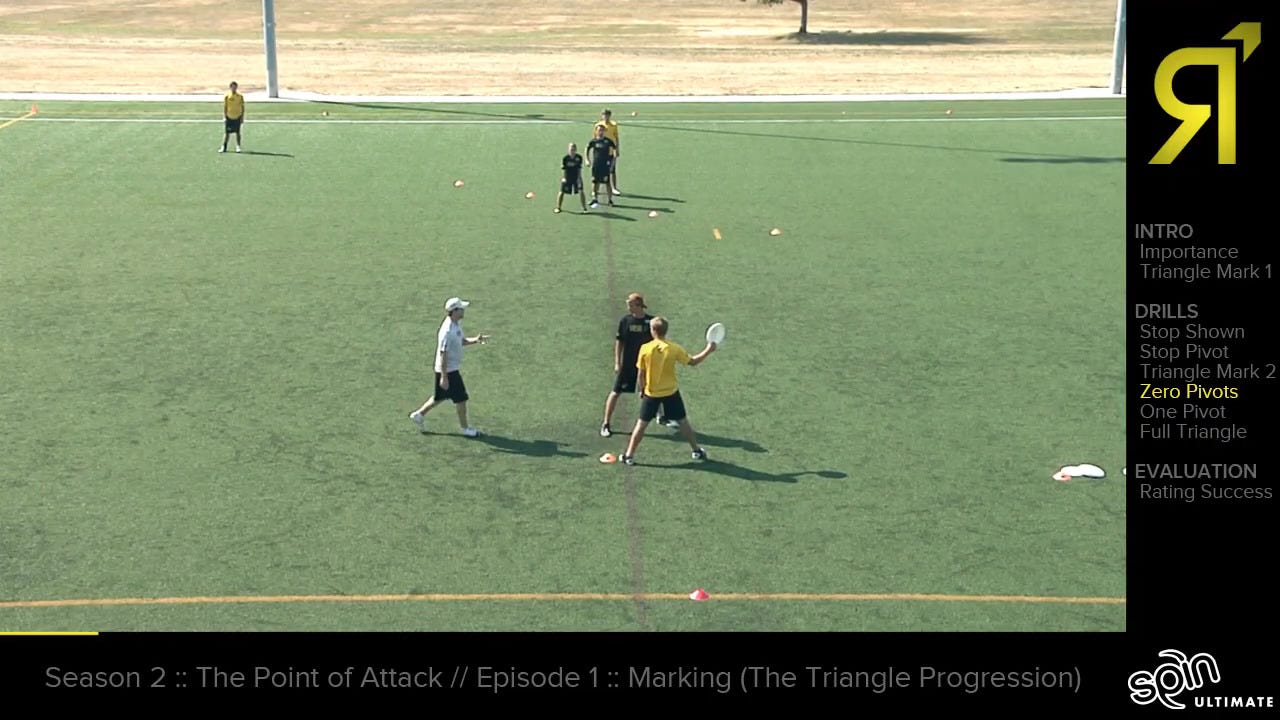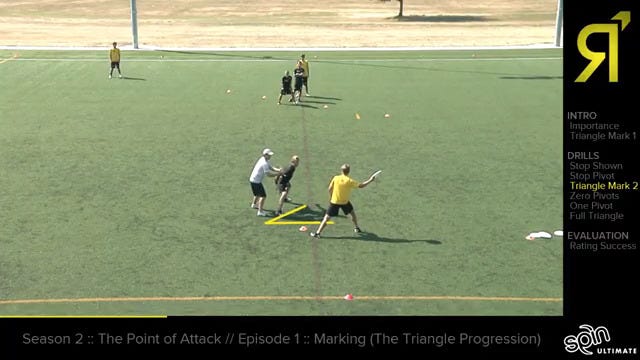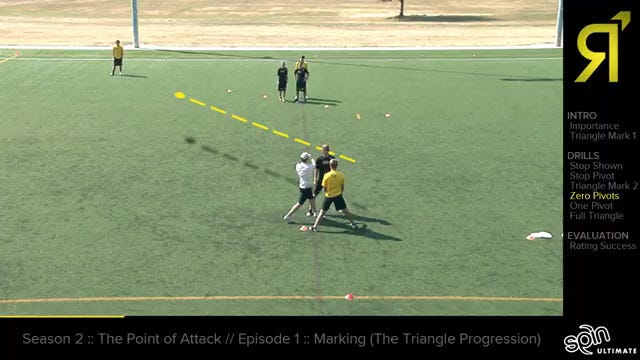Triangle marking is (mostly) nonsensical
A clever idea that doesn't really work in practice
The "triangle marking" progression has never really made sense to me.
For anyone who's not familiar with it, here's the famous RISE UP Triangle Progression video:
There's a very old Reddit thread that asked "Why is the triangle marking technique beneficial?", saying:
So I watched this video...I really don't understand how this is beneficial, it seems way too easy to break the mark...
However, none of the commenters really agreed with the poster; instead, they answered the poster's question and tried to explain why it's beneficial. And triangle marking is mentioned positively in lots of other threads about marking as well, like here, here, or here.
But I've always instinctively agreed with the poster of that old thread. Triangle marking seems silly. If there's a best place to be to block a certain throwing lane, why wouldn't we want to be there all the time?
Here’s what I think is wrong with triangle marking:
Do whatever you want against bad throwers
My first complaint about this video: the throwers are unrealistically bad. I think someone once said "great throwers don't pivot". To the extent the Triangle Progression looks good in the RISE UP video, it's aided by how every thrower pivots, every time.
There are no half-pivot backhands. No one who marks me like they do in the image below is ever stopping me from throwing a half-pivot backhand break (at least partly because I'm not holding the disc that far from my body):
Nor are there any shimmies in the RISE UP drill-world. Any mark that's that responsive to the thrower—shuffling multiple feet every time they pivot—is just getting faked out every time.
Even when a good thrower does pivot to the backhand around, they don't need to pivot back fully in order to throw an inside flick:
(Source: Lia Schwartz Callahan video)
Instead, in the video we see throwers who are very wasteful with their motions. I don't know what RISE UP is teaching people but I've never seen a great thrower bring the disc way above their head when pivoting from the backhand side back to the forehand side, the way MULTIPLE throwers do in this video:
The triangle progression might work against some thrower who's doing whatever this is...:
...but it's not going to work against Lia Schwartz. If you shuffle that far to stop her around throw, she's already got you beat to the inside lane. She's already released the throw at the moment this guy has the disc inexplicably far above his head.
It only works for some triangles
With that out of the way, let's actually break down the triangle progression itself.
I'd say there are two possible ideas that underlie why the triangle progression feels like it might work.
The first idea is that the triangle works because it's a quicker path back to the throwing lane. To quote a 2016 Reddit thread discussing triangle marking:
when the thrower comes back to the inside break, you take the shortest path to the lane (which is the "jump back").
It's not impossible this is true! The sides of (most) triangles aren't all the same length, so it's not impossible that taking the shortest path back to the throwing lane (which defines one side of the triangle) involves getting further away from the thrower.
For example, here's (two sides of) a triangle drawn on the screen at one point in the RISE UP video:
The two yellow lines are the two paths traveled by the marker during the progression. The third side, if we're using the "shortest path back to the throwing lane" logic, is obviously the throwing lane. So the triangle drawn on the screen in the image above implies a throwing lane that looks something like this:

That implied lane matches reasonably well with the special effects drawn on the screen later in the video:
But...when the thrower is allowed to actually throw a pass a bit later, they attempt an inside forehand into a noticeably more vertical lane:
Let's overlay this actual throwing lane on RISE UP's suggested progression:
The "shorter" path back to the throwing lane is partly shorter because they didn't draw it long enough to actually get the marker back to the lane. I'm going to try not to get too math-y here, but hopefully this example highlights a general rule:
The more vertically downfield the inside throwing lane "points", the longer the "jumping back"/"sagging" path to the throwing lane becomes. For some triangles, sagging off is the longer path.
Also, notice the point where the two yellow lines come together. It's not in the backfield at all. If you move into the backfield as a marker, and that yellow intersection point moves towards the bottom of the screen, the "shortest path back" becomes less and less of a triangle. The more you try to block the around, the less a triangle makes sense when moving back to block the inside lane.
In the general case, an infinite number of "triangles" are possible depending on how far you shuffled as a mark and where the next throwing lane is. Some of those are actual triangles, where you can "get back to the throwing lane" most quickly by sagging off the thrower. But many of them are not, and you're better off just going back along the same lane that got you to that point. And of course, there's another factor here that I haven't mentioned: you don't know exactly where the throwing lane is. A triangle could work if you know exactly where the downfield cutter is going to be, but if the throwing lane is more vertical than you expect, a triangle is a worse solution.
To actually use the triangle progression correctly requires you to do calculus with hidden information.
There's one final thing to point out about this whole situation: as this discussion highlights, a triangle makes more sense when you're trying to block less of the field. The diagrams in the RISE UP video show a marker not even taking away the "around" lane, but also barely taking away the inside flick lane. At that point, you're probably better off just not even moving as a marker. If you are going to move, the more you think you can take away, the less you should be thinking of using triangles.


Being further away doesn't help against curved throws
The other reason a triangle might work is that, independent of whether you're getting to the throwing lane faster, you have more time to react to the thrower when you're farther away from them. It takes a few extra fractions of a second for the disc to get past you when you're five feet away from the thrower than it does when you're a foot away from them. That gives you a little more time to move further to block a throw.
But both the "more time to react" logic and "shortest path back to the lane" logic have the same problem—they only work if the throwing lane is a straight line.
Although the RISE UP video linked above only suggests "stepping back" to stop the inside throw1, in my experience, that advice has morphed somewhat into a more general idea that stepping back is an effective way to block a lane. See this comment from one of the Reddit threads linked above:
The triangle marking progression is a great way to understand how to close a lane and then re-establish a proper, honest mark.
To that commenter, it's about "closing a lane", not "closing the inside lane" specifically. Or this comment from a different thread:
You can stop both if you use your feet to move and follow kind of a triangle pattern: As you move over to block the around, step back a bit so the thrower can't get around you. Then close the gap. If you jump back to stop the inside, take a step back as you step over to get that extra space to keep the thrower from going around you. [emphasis added by me]
But stepping back only keeps you close to the lane if the lane is a flat, straight line. If a thrower can curve a throw around you, you're just making it even easier for them by stepping back. Here's a moment I noticed in a UFA game (paywalled) that exemplifies this problem:
As the throw goes up to Philadelphia's Sean Mott, the Toronto Rush defender looks like they're on a good line to set an immediate tight mark:
But then they look downfield and see the continuation cut coming:
And as a result, they peel off and set a loose mark:
...which Mott promptly throws around with an OI forehand as if the marker isn't even there.
For any curved throw, your only real way to affect it is to set a reasonably tight mark. When the throwing lane curves away from you, dropping off the thrower is just making it harder to block the throwing lane. I'm not sure what the frisbee world was like when this video was first released, but I'd say any reasonably good thrower today is just going to happily throw around your loose mark with and OI or OIIO or scoober or lefty backhand or…
One other thing worth noting here: when you're closer to the thrower, you can make it harder for them to pivot in certain directions. The further away you are, the more they can pivot as far as they want in exactly the direction they want to get the pass around you.
In summary
Triangle marking maybe makes sense if you know the angle between the two lanes you're trying to block is small enough. And triangle marking maybe makes sense against a thrower that doesn't have curved throws (or it's windy enough that curved throws are untrustworthy even for good throwers).
But for the most part, I think it's overhyped and overused. Even in the limited situations where the geometry of the triangle makes sense, a good thrower will just curve the disc around your loose mark. In my opinion, you're better off just setting a reasonably tight mark no matter what you're trying to take away.
RISE UP doesn't explain why you wouldn't want to "step back" in both directions. Another thing that never made sense to me about the triangle progression—if it works one way, shouldn't it work the other way?










I don’t follow that prescriptive of a marking pattern, but I do backup sometimes.
You mention here that you need to be a little farther away to take in as much perceptual information https://open.substack.com/pub/someflow/p/how-to-get-handblocks-like-john-mcdonnell?utm_campaign=post&utm_medium=web . Too close makes it easy for the mark to step through you too.
I also step off on force side throws sometimes. I’ve gotten a few handblocks doing that because it gives me time to get there. More importantly, it gives me the position to recover to give gos.
I think this is spot on.
Sagging to the break side won't work unless you can sag far enough to actually double-team the receiver. It's too easy to just throw around/over you.
But it gets worse. When you sag, you aren't contesting throws on the dump/force side at all. With no mark, it is trivial to dish to another handler in a power position. And you, 5 feet off to the break side, will be disastrously out of position as your mark cuts upfield for an easy continue.
There is one thing I think the triangle mark gets right, and that's step 1: taking away the shown throw. It's okay to get broken sometimes (and, let's be honest, good throwers are going to break you anyway). What's not okay is to put zero pressure on the thrower.